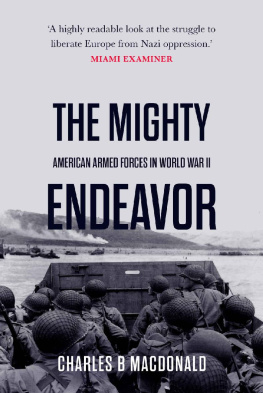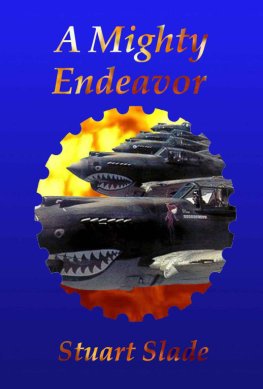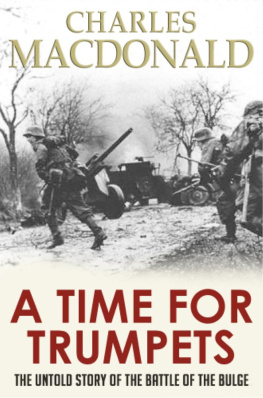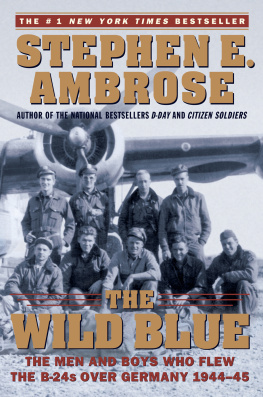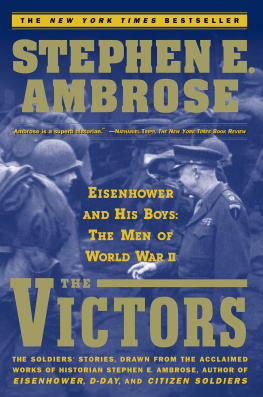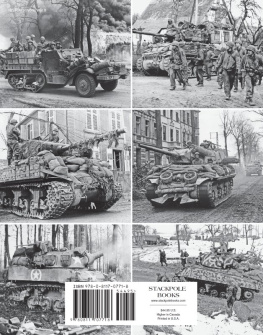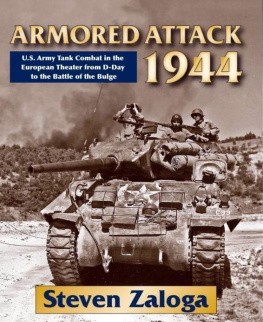The Mighty Endeavor: American Armed Forces in the European Theater in World War II
Charles B. MacDonald
Copyright Charles B. MacDonald 1969
The right of Charles B. MacDonald to be identified as the author of this work has been asserted by him in accordance with the Copyright, Designs and Patents Act, 1988.
First published in the United Kingdom in 1969 by Oxford University Press
This edition published in 2018 by Endeavour Media Ltd.
For Mary MacQueen MacDonald, who had four in it
Table of Contents
Almighty God Our sons, pride of our nation, this day have set upon a mighty endeavor, a struggle to preserve our Republic, our religion, and our civilization and to set free a suffering humanity...
from President Franklin D. Roosevelts statement on D Day, 6 June, 1944
Chapter One The Path to Decision
It was not in the American image to plan for war when there was no war.
Spontaneity and improvisation, the record would show, were virtues in the American way of waging war. Not longer ago than 1915, when responsible officials in the War Department had dared to plan for the possibility of war with Germany and let word of it reach the press, President Woodrow Wilson, trembling and white with passion, had threatened to relieve and order out of Washington every officer of the General Staff.
Hiding behind the illusion that the world had seen the last of warfare on a grand scale, Americans in the twenties and much of the thirties had comfortably donned the blinders of isolationism. They read their Sinclair Lewis, their Dreiser, their Fitzgerald, their Civil War romances. They idolized a new species of talking, singing film stars; persecuted and then lamented Saeeo and Vanzetti; made a millionaire out of Henry Ford, a demigod of Charles A. Lindbergh, Jr. They rode in the rumble seat; outlawed the liquor they drank; applauded the naval limitation conferences and the Kellogg-Briand Pact while reserving the League of Nations for the immoral European states that needed it. Having added one teetering building block after another to their economy until it inevitably came tumbling down, they drove Hoover carts, played Monopoly, and went to bank night at the movies. Half in desperation, to set their little insular world right again, they unwittingly voted in a kind of socialism they earlier had disdained.
As for a military establishment, that was a necessary evil, good for an honor guard, for chasing bonus marchers off the Anacostia flats, or for an occasional headline, as when airman Billy Mitchell, who claimed to have had a vision that would dispense with warfare on ground and sea, challenged the traditionalists and to hell with the consequences! Yet in general the sign reputedly found in a Texas caf caught the prevailing mood:
DOGS AND SOLDIERS NOT ALLOWED
The Navy, of course, was different, made up as it was of a composite Dick Powell-Fred Astaire who came crooning and dancing into port to an Irving Berlin score into the waiting aims of Ruby Keeler-Ginger Rogers. Nor was there concern, in view of the restrictions imposed by the naval conferences with Great Britain and Japan, that the Navy might grow so large as to invite war. In 1933 the Navy had only 91,000 men and 1,186,000 tons of ships.
As for the Army, the National Defense Act of 1920 had decreed that at maximum strength it should be a hard, lean force of 280,000. It was actually a neglected, spavined, meager force of only 135,000, little more than the Versailles Treaty allowed defeated Germany. That left it in seventeenth place among the armies of the world.
Incredible that within those skeletal and impoverished organizations, and with the scorn in which they were held, there were men who could do more than play at the game of soldier or sailor. More remarkable still, in view of the national determination to outlaw war by ignoring war, there were men in those establishments who had the heart to plan for war. Yet there were such men. There was, too, the apparatus by means of which they could engage in strategic planning, however theoretical, even abstract.
That was the Joint Board, which was composed of equal numbers of Army and Navy officers, including the Armys Chief of Staff and the Chief of Naval Operations, and was charged with handling all matters requiring cooperation between the two services. To the original Joint Board of the World War had been added a joint Planning Committee, composed of four officers each from the War Plans divisions of the Army and the Navy. Neither this committee nor the Joint Board itself had the power of command or ultimate decision, which was reserved, in the end, to the President; but decisions would be made on the basis of the deliberations of the Joint Board. If spontaneity and improvisation ceased to be virtues in the war to come, these men, in large measure, would be responsible.
During the twenties and early thirties it was difficult to find likely enemies upon which the joint planners might legitimately focus. Yet the planners dutifully catalogued several and gave a color code name to the war plan dealing with each even Great Britain (RED). This was nevertheless little more than theoretical, for the Great War had left most European nations destitute. The only likely enemy meriting serious consideration was in the Pacific. There Japan (ORANGE), strengthened by emerging industrialization and by a peripheral, opportunistic engagement in the war, had long displayed expansionist tendencies.
So long as no European power emerged as a real threat to peace, no disagreement would arise between Army and Navy planners over the priority to be accorded war in the Pacific. Although the ORANGE plan as adopted in 1924 foresaw primarily a naval war, with the Armys role distinctly secondary, no ugly interservice jealousy arose. Not even consideration of a combined RED-ORANGE plan based on the possibility of a two-front war with Britain and Japan could turn the Armys head toward the Atlantic, possibly because the likelihood of any war with Britain appeared, if not impossible, at least immoral.
However unrealistic the thought of war with Britain, there emerged from the RED-ORANGE planning a theory, a concept, however tentative, bearing though no one knew it at the time tremendous import for the future. In a war with Japan, the planners believed, the chance of the Japanese seizing Hawaii, Panama, and certainly any part of the continental United States was remote; but in a war with Britain the threat of invasion would be real. Since the United States in a combined RED-ORANGE war would lack the resources to fight offensively at the same time in both Pacific and Atlantic, the more serious threat posed in the Atlantic might have to be eliminated first.
It is not unreasonable to hope, the planners noted more prophetically still, that the situation at the end of the struggle with RED may be such as to induce ORANGE to yield rather than face a war carried to the Western Pacific.
Despite a past record of British naval intransigence, war with Britain nevertheless remained so improbable that no combined RED-ORANGE plan was officially adopted. Well past the midpoint of the thirties, the ORANGE plan, with its focus on the Pacific and Japan, drew most attention. Growing Japanese militarism, as exemplified by invasion of Manchuria in 1931 and full-scale war with China in 1937, along with bombing of the American gunboat Panay , was sufficient justification for continuing concern.
Yet in the meantime, threats and actual aggression had emerged in Europe as well. In 1935, Benito Mussolinis Italy, virtually egged on by the impotence of the League of Nations, attacked Ethiopia; and in 1936, while civil war ravaged Spain, Adolf Hitler sent a revived German army into a demilitarized Rhineland.
Late in 1937, in recognition of world developments, the Joint Board directed the planners to re-examine the ORANGE plan. Explicit was the continuing belief that Japan still posed the principal threat; but the planners also were to consider the possibility that the United States might become involved at the same time in a war with some European power.
Next page
